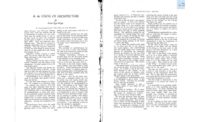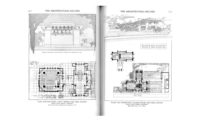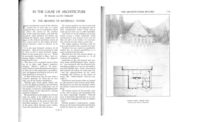From Architectural Record, March 1908. Read a PDF of the original article here.
The reader of architectural discourses encounters with increasing frequency discussions on American Architecture, Indigenous Architecture. These are generally to the effect that in order to establish a vital architecture in the United States, it is necessary for the architect to sever his literal connection with past performances, to shape his forms to requirements and in a manner consistent with beauty of form as found in Nature, both animate and inanimate. Articles in this strain have appeared, from time to time, in this and in other architectural journals, and have been in most cases too vague in their diction to be well understood, either by the lay reader or the architect.
The sentiment for an american architecture first made itself felt in Chicago twenty years ago. Its earliest manifestation is the acknowledged solution of the tall office building problem. An original phase of that early movement is now presented, in the following article and illustrations, the work of Mr. Frank Lloyd Wright.
—Editors of THE ARCHITECTURAL RECORD
Radical though it be, the work here illustrated is dedicated to a cause conservative in the best sense of the word. At no point does it involve denial of the elemental law and order inherent in all great architecture; rather it is a declaration of love for the spirit of that law and order and a reverential recognition of the elements that made its ancient letter in its time value and beautiful.
Primarily, Nature furnished the materials for architectural motifs out of which the architectural forms as we know them today have been developed, and, although our practice for centuries has been for the most part to turn from her, seeking inspiration in books and adhering slavishly to dead formulae, her wealth of suggestion is inexhaustible; her riches greater than any man's desire. I know with what suspicion the man is regarded who refers matters of fine art back to Nature. I know that it is usually an ill-advised return that is tempted, for Nature in external, obvious aspect is the usually accepted sense of the term and the nature that is reached. But given inherent vision there is no source so fertile, so suggestive, so helpful aesthetically for the architect as a comprehension of natural law. As Nature is never right for a picture so is she never right for the architect-that is, not ready made. Nevertheless, she has a practical school beneath her more obvious forms in which a sense of proportion may be cultivated, when Vignola and Vitruvius fail as they must always fail. It is there that he may develop that sense of reality that translated to his own field in terms of his own work will lift him far above the realistic in his art: there he will be inspired by sentiment that will never degenerate to sentimentality and he will learn to draw with a surer hand the every-perplexing line between the curious and the beautiful.
A sense of the organic is indispensable to an architect; where can he develop it so surely as in this school? A knowledge of the relations of form and function lies at the root of his practice; where else can he find the pertinent object lessons Nature so readily furnishes? Where can he study the differentiations of form that go to determine character as he can study them in the trees? Where can that sense of inevitableness characteristic of a work of art be quickened as it may be by intercourse with nature in this sense?
Japanese art knows this school more intimately than that of any people. In common use in their language there are many words like the word edaburi which, translated as near as may be, means the formative arrangement of the branches of a tree. We have no such word in English, we are not yet sufficiently civilized to think in such terms, but the architect must not only learn to think in such terms but he must learn in this school to fashion his vocabulary for himself and furnish it in a comprehensive way with useful words as significant as this one.
For seven years it was my good fortune to be the understudy of a great teacher and a great architect, to my mind the greatest of his time -- Mr. Louis H. Sullivan.
Principles are not invented, they are not evolved by one man or one age, but Mr. Sullivan's perception and practice of them amounted to a revelation at a time when they were commercially inexpedient and all but lost to sight in current practice. The fine-art sense of the profession was at that time practically dead; only glimmerings were perceptible in the work of Richardson and of Root.1
Adler and Sullivan had little time to design residences. The few that were unavoidable fell to my lot outside of office hours. So largely, it remained for me to carry into the field of domestic architecture the battle they had begun in commercial building. During the early years of my own practice I found this lonesome work. Sympathizers of any kind were then few, and they were not found among the architects. I well remember how "the message" burned within me, how I longed for comradeship until I began to know the younger men and how welcome was Robert Spencer, and then Myron Hunt, and Dwight Perkins, Arthur Heun, George Dean, and Hugh Garden. Inspiring days they were. I am sure, for us all. Of late we have been too busy to see one another often, but the "New School of the Middle West"2 is beginning to be talked about and perhaps some day it is to be. For why not the same "Life" and blood in architecture that is the essence of all true art?
In 1894, with this text from Carlyle at the top of the page-"The ideal is within thyself, thy condition is but the stuff thou art to shape that same ideal out of" -- I formulated the following "propositions." I set them down here much as they were written then, although in the light of experience they might be stated more completely and succinctly.
I — Simplicity and Repose are qualities that measure the true value of any work of art.
But simplicity is not in itself an end nor is it a matter of the side of a barn but rather an entity with a graceful beauty in its integrity from which discord, and all that is meaningless, has been eliminated. A wildflower is truly simple. Therefore:
- A building should contain as few rooms as will meet the conditions which give it rise and under which we live and which the architect should strive continually to simplify; then the ensemble of the rooms should be carefully considered that comfort and utility may go hand in hand with beauty. Beside the entry and necessary work rooms there need be but three rooms on the ground floor of any house, living room, dining room, and kitchen, with the possible addition of a "social office"; really there need be but one room, the living room, with requirements otherwise sequestered from it or screened within it by means of architectural contrivances.
- Openings should occur as integral features of the structure and form, if possible, its natural ornamentation.
- An excessive love of detail has ruined more fine things from the standpoint of fine art or fine living than any one human shortcoming-it is hopelessly vulgar. Too many houses, when they are not little stage settings or scene paintings, are mere notion stores, bazaars, or junk shops. Decoration is dangerous unless you understand it thoroughly and are satisfied that it means something good in the scheme as a whole, for the present you are usually better off without it. Merely that it "looks rich" is no justification for the use of ornament.
- Appliances or fixtures as such are undesirable. Assimilate them together with all appurtenances into the design of the structure.
- Pictures deface walls oftener than they decorate them. Pictures should be decorative and incorporated in the general scheme as decoration.
- The most truly satisfactory apartments are those in which most or all of the furniture is built in as a part of the original scheme considering the whole as an integral unit.
II — There should be as many kinds (styles) of houses as there are kinds (styles) of people and as many differentiations as there are different individuals. A man who has individuality (and what man lacks it?) has a right to its expression in his own environment.
III — A building should appear to grow easily from its site and be shaped to harmonize with its surroundings if Nature is manifest there, and if not try to make it as quiet, substantial and organic as She would have been were the opportunity Hers.*
We of the Middle West are living on the prairie. The prairie has a beauty of its own, and we should recognize and accentuate this natural beauty, its quiet level. Hence, gently sloping roofs, low proportions, quiet skylines, suppressed heavyset chimneys and sheltering overhangs, low terraces and outreaching walls sequestering private gardens.
IV — Colors require the same conventionalizing process to make them fit to live with that natural forms do; so go to the woods and fields for color schemes. Use the soft, warm, optimistic tones of earths and autumn leaves in preference to the pessimistic blues, purples, or cold greens and grays of the ribbon counter; they are more wholesome and better adapted in most cases to good decoration.
V — Bring out the nature of the materials, let their nature intimately into your scheme. Strip the wood of varnish and let it alone--stain it. Develop the natural texture of the plastering and stain it. Reveal the nature of the wood, plaster, brick, or stone in your designs, they are all by nature friendly and beautiful. No treatment can be really a matter of fine art when these natural characteristics are, or their nature is, outraged or neglected.
VI — A house that has character stands a good chance of growing more valuable as it grows older while a house in the prevailing mode, whatever that mode may be, is soon out of fashion. stale, and unprofitable.
Buildings like people must first be sincere, must be true, and then withal as gracious and lovable as may be. Above all, integrity. The machine is the normal tool of our civilization. give it work that it can do well-nothing is of greater importance. To do this will be to formulate new industrial ideals, sadly needed.
These propositions are chiefly interesting because for some strange reason they were novel when formulated in the face of conditions hostile to them and because the ideals they phrase have been practically embodied in the buildings that were built to live up to them. The buildings of recent years have not only been true to them, but are in many cases a further development of the simple propositions so positively stated then.
Happily, these ideals are more commonplace now. Then the skylines of our domestic architecture were fantastic abortions, tortured by features that disrupted the distorted roof surfaces from which attenuated chimneys like lean fingers threatened the sky; the invariably tall interiors were cut up into box-like compartments, the more boxes the finer the house, and "Architecture" chiefly consisted in healing over the edges of the curious concoction of holes that had to be cut in the walls for light and air and to permit the occupant to get in or out. These interiors were always slaughtered with the butt and slash of the old plinth and corner block trim, of dubious origin, and finally smothered with horrible millinery.
* In this I had in mind the barren town lots devoid of tree or natural incident, townhouses and board walks only in evidence.







